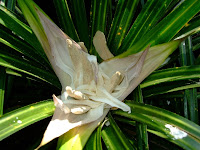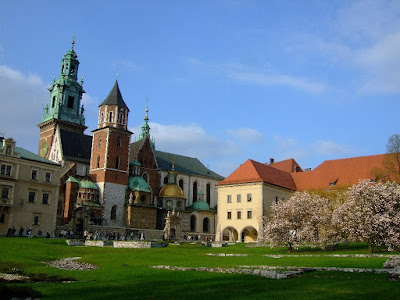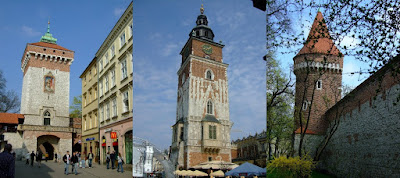
What can one write about Auschwitz that has not already been said? It seemed incongruous to be visiting this scene of unspeakable horror and death on a beautiful spring day with the fresh new spring growth, the symbol of life and a future, budding all around us.
It is a full day excursion so

we were up and on our way to the bus station early to catch the express bus from Krakow, only to find a long queue at the only open ticket office and then find all the seats sold. The next bus was 50 minutes later so we spent the time nattering to two other Kiwi couples before setting off for the 90-minute journey. We were still in time for the 11 a.m. English tour with Berta, a wonderful guide.
Auschwitz-I was a men only camp using an existing army barracks so was relatively palatial compared to the rigours of Auschwitz-II or Birkenau.

How anyone survived winter in that bleak place in those camp buildings is a mystery. Prefabricated stables not holding the 52 horses they were designed for but rather 400+ prisoners, three levels deep, in incomprehensible conditions is just too hard for us to imagine or identify with.
The dehumanising processes, controls and conditions, graphically recounted by the guide and the display boards,

are simply too much to absorb and while the information is processed by the brain the horror cannot really be understood. There were no trees breaking the view then, there was no grass underfoot, there was only death for the majority and a 10km walk each way to the work sites for the 'healthy' ones.
The strength of the human instinct to survive is evidenced in so many ways: whether in the pile of bodies under the air vents as they clambered on the bodies of others for the last gasps of fresh air in the gas chambers; or in the motivation of the capos who would treat their fellows more harshly than the SS in the hope of

buying a few more days; or those who felt themselves fortunate to have the task of cleaning the latrines and so on. With the certain knowledge of the finality of the solution waiting for them in the gas chambers at the far side of the camp there were those who hoped with a hope so far beyond hope that the new day might bring life instead of death and so endured for one more day and one more day.

Why they simply did not give up is truly something that we, in our cushy western world, cannot begin to understand.
The mentality of the Germans captors is also hard to comprehend. Apart from the obvious question as to how any rational person could be part of such barbarity, the fact that they would photograph and record the name, date of birth, date of arrival at the camp and date of death of a prisoner that was to be killed that same day is mind-boggling. Later the numbers murdered precluded any such record keeping

but did not stop them collecting the toothbrushes, hair brushes, shaving brushes and so on.
But soon it was time to return and the bus timetable was not running the full service so it was a toss-up which bus to try for. We got back to Auschwitz-I in time for the 16:20 but it was full so we decided not to stand for 90 minutes. We had another look around the camp and then set off for the 17:30 bus. Before long there was at least two bus loads of people standing around and certainly not in a orderly British queue. I had stationed myself at the kerbside where I estimated the bus door would be and we stood and waited. Sure enough the door was directly in front of me when the

bus arrived and we smuggly took our seats while the melee outside the door attempted to board the bus.
Eventually we left, but less than five minutes later the bus died and we had to wait for a replacement. Now those standing in the aisle had a distinct advantage over those of us in the seats as we scrambled from one bus to the next. Fortunately we secured seats again, just.
Dinner that evening continued the Jewish theme as we ate in the old Jewish quarter at a

restaurant called “Once Upon A Time in Kazimierz”. Walls have been removed to amalgamate four old Jewish establishments: The General Store; a Tailors workroom and shop; a carpentry workshop and a Grocery store. Each section is furnished and decorated to reflect its original use giving the restaurant a wonderful atmosphere; complimented by the delicious food.
 To celebrate 85 years of the MG marque, the Windsor Rotary Club and several MG clubs organised the Royal Windsor MG Heritage Festival as fundraiser for The Prince Philip Trust Fund and other Rotary charities.
To celebrate 85 years of the MG marque, the Windsor Rotary Club and several MG clubs organised the Royal Windsor MG Heritage Festival as fundraiser for The Prince Philip Trust Fund and other Rotary charities. newest 85th Anniversary Edition TF, which was unveiled to the public at the display. The earliest models that made it were two from 1925, one of which had spent most of its life in NZ. It was a fantastic turnout of some extremely beautiful examples of the MG Marque down through the years and we were chosen to represent 1950 and the YA model.
newest 85th Anniversary Edition TF, which was unveiled to the public at the display. The earliest models that made it were two from 1925, one of which had spent most of its life in NZ. It was a fantastic turnout of some extremely beautiful examples of the MG Marque down through the years and we were chosen to represent 1950 and the YA model. To get 221 cars assembled and into the right order after the requisite security checks meant that it was a farily early start to the day. We were car number 77 in the parade as we made our way though the crowds in Windsor and then enjoyed the rare privilege of driving up Castle Hill and through St George's Gate into the private area of the Castle.
To get 221 cars assembled and into the right order after the requisite security checks meant that it was a farily early start to the day. We were car number 77 in the parade as we made our way though the crowds in Windsor and then enjoyed the rare privilege of driving up Castle Hill and through St George's Gate into the private area of the Castle.  We then drove around the Royal Quadrangle where HRH gave us a wave and then out of the castle and through the private grounds into Frogmore Drive and down to a parking area by the cricket grounds.
We then drove around the Royal Quadrangle where HRH gave us a wave and then out of the castle and through the private grounds into Frogmore Drive and down to a parking area by the cricket grounds. Once we were all assembled there HRH drove himself down in his Range Rover and planted a tree, as did Mr He Xiaoqing the Chairman of MG Motors UK. Mr He then presented HRH with the keys to a brand new MG TF LE500 to be auctioned as part of the fundraising. With the formal bits over, the public were allowed in to look at the cars and we were allowed out so went for a walk down the long drive to see the other 600+ MGs that had assembled there to be part of the day.
Once we were all assembled there HRH drove himself down in his Range Rover and planted a tree, as did Mr He Xiaoqing the Chairman of MG Motors UK. Mr He then presented HRH with the keys to a brand new MG TF LE500 to be auctioned as part of the fundraising. With the formal bits over, the public were allowed in to look at the cars and we were allowed out so went for a walk down the long drive to see the other 600+ MGs that had assembled there to be part of the day.

















































